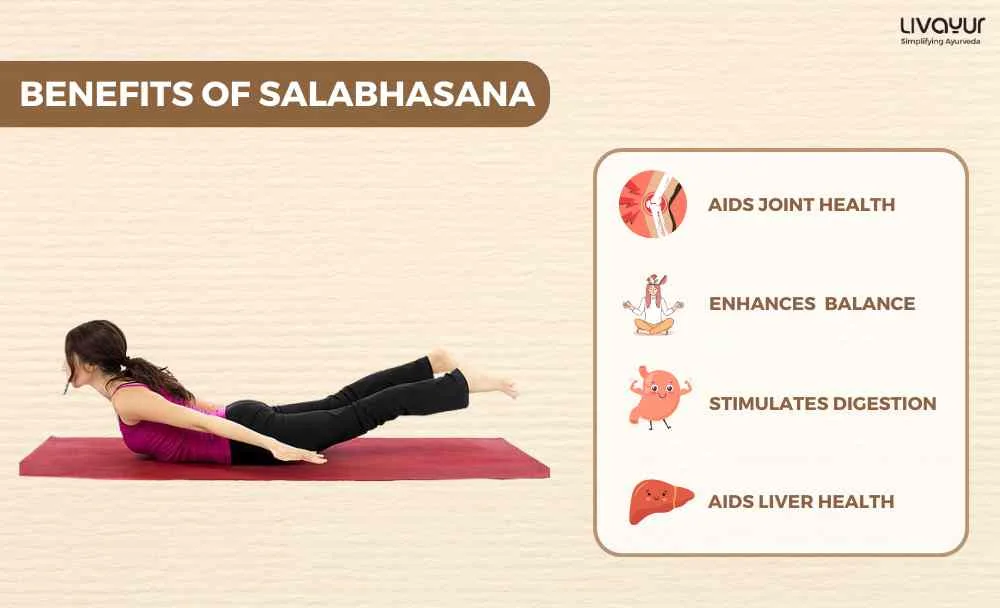This article is reviewed by an expert
Yoga is a holistic practice that encompasses physical postures, breath control, meditation, and ethical principles. It is considered one of the best ways to improve your strength, flexibility, physical health and mental well-being.
One powerful posture in yoga is Salabhasana, also known as the Locust Pose. Let’s find out more about this asana and its many benefits in this article.
What Is Salabhasana (1)?
Salabhasana, also known as the Locust Pose, is an essential yoga posture described in the ancient text Gheranda Samhita as one of the 32 most important asanas. The name Salabhasana is derived from the Sanskrit word “Shalabh,” which means locust or grasshopper, as it resembles the posture of a locust or grasshopper.
Salabhasana Steps (1)
- Lie down on the floor, facing downwards, with your stomach on the ground.
- Extend your arms straight back along your body, keeping them parallel to the floor.
- Simultaneously lift your head, chest, and legs off the floor as high as possible. Ensure that only the abdominal portion of your body remains in contact with the floor, and avoid placing weight on your hands or resting your ribs on the ground.
- Engage your buttocks by contracting them and stretching your thigh muscles.
- Keep both legs fully extended and straight throughout the pose.
- Avoid putting weight on your hands. Instead, stretch them back to engage and exercise the upper portion of your back muscles.
- Maintain the position for as long as you comfortably can while breathing normally.
Salabhasana Benefits (1)
Ankle and Foot Flexibility
Primary Benefits: Salabhasana strengthens and stretches the muscles responsible for ankle plantar flexion and foot inversion.
Secondary Benefits: As a result, it helps promote flexibility in the ankle and foot, improving the range of motion.
Knee Stability
Primary Benefits: Salabhasana engages the quadriceps femoris and hamstring muscles, thereby strengthening and toning the muscles around the knee joint.
Secondary Benefits: It also increases stability in the knee joint by activating the extensors of the knee.
Hip Strength
Primary Benefits: Salabhasana enhances hip extension, improving flexibility and strength in the gluteus maximus and hamstring muscles.
Secondary Benefits: Additionally, it also works the adductor muscles of the hip, promoting balance and stability.
Spine Extension
Primary Benefits: Salabhasana extends the spine, activating the back extensor muscles and promoting good posture.
Secondary Benefits: It also strengthens the muscles of the abdominal wall, including the rectus abdominis and oblique muscles.
Shoulder Joint Mobility
Primary Benefits: Salabhasana externally rotates the shoulder joint, engaging the infraspinatus, teres minor, and deltoid muscles.
Secondary Benefits: It also provides a minor stretch to the antagonist muscles of the shoulder joint.
Elbow Joint Integrity
Primary Benefits: Salabhasana extends the elbow joint, strengthening the triceps brachii and anconeus muscles.
Secondary Benefits: In addition, it also pronates the forearm, activating the pronator teres and pronator quadratus muscles.
Additional Benefits of Salabhasana (1)
- It strengthens the lower back and pelvic organs, providing relief from backache, mild sciatica, and slipped discs.
- It helps tone and balance the functioning of the liver, stomach, bowels, and other abdominal organs.
- It stimulates digestion, relieves constipation and aids in relieving gastric troubles and flatulence.
- It helps increase the elasticity of the spine and alleviates pain in the sacral and lumbar regions.
- It benefits the bladder and prostate gland, promoting overall health in these areas.
On a Final Note
Incorporating Salabhasana into your yoga practice can bring numerous benefits to your body and mind. Strengthening and stretching various muscles, this pose improves ankle and foot flexibility, knee stability, hip strength, spine extension, shoulder joint mobility, and elbow joint integrity.
Additionally, Salabhasana also provides relief from back pain, enhances digestion and promotes overall health in abdominal and pelvic organs.
However, you must remember to approach the pose with mindfulness and listen to your body’s limits. You can also take the help of a yoga teacher to learn the pose.
FAQs (1)
- Is Salabhasana suitable for beginners?
Yes, Salabhasana can be practised by beginners. However, it is important to approach the pose with caution and listen to your body’s limits. It is recommended to take the help of a yoga practitioner to approach the pose properly.
- Can Salabhasana help with back pain?
Yes, Salabhasana is known to strengthen the lower back muscles and alleviate back pain. It helps improve the flexibility and elasticity of the spine, providing relief from backache, mild sciatica, and slipped discs.
- How long should I hold Salabhasana?
The duration of holding Salabhasana can vary depending on your comfort level. Initially, you can start by holding the pose for a few seconds and gradually increase the duration as your strength and flexibility improve. Aim for holding it for at least 10-30 seconds to experience the benefits.
- Can Salabhasana improve digestion?
Yes, Salabhasana stimulates digestion and can help relieve constipation and gastric troubles. By engaging the abdominal muscles and enhancing circulation in the abdominal area, it promotes healthy digestion and aids in relieving flatulence.
Disclaimer: This article is written from a health and lifestyle perspective. It is for general information and not meant to substitute any medical advice. Please consult your doctor for appropriate medical consultation.
References


















